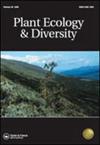Plant invasion depresses native species richness, but control of invasive species does little to restore it
IF 1.6
4区 生物学
Q2 PLANT SCIENCES
引用次数: 5
Abstract
ABSTRACT Background Invasive plants are associated with the decline of native plant richness, but the impact of removal of invasives on native plant richness is often unknown. Aims We investigated whether the presence of the introduced plant Centaurea solstitialis (Asteraceae) was correlated with reduced native plant richness; whether rain in late spring, when C. solstitialis is virtually the only plant actively growing, increased its cover; and whether native species richness increased following the control of C. solstitialis. Methods From 2011 to 2017 in a grassland in Sonoma County, California, USA, we treated 20 1-m2 plots in C. solstitialis-invaded patches with chemical and mechanical removal. We monitored cover of all plants in those plots, plus 20 invaded untreated and 20 uninvaded plots, for a total of 60 plots in two blocks. Results Native plant richness was lower in invaded than in non-invaded plots. More late spring rainfall resulted in greater C. solstitialis cover in the following year. Native species richness in the six years after initial removal was slightly higher in removal plots than in untreated control plots. Conclusions Centaurea solstitialis removal alone results in modest benefits for native plant species richness. Managing this invasive requires more resources in years with more late spring rainfall.植物入侵降低了本地物种的丰富度,但控制入侵物种对恢复其丰富度作用不大
背景入侵植物与本地植物丰富度的下降有关,但入侵植物的清除对本地植物丰富度的影响往往是未知的。目的研究引进植物半毛菊(Centaurea solstitialis)是否与本地植物丰富度降低相关;晚春的雨水是否增加了冬青的覆盖度,冬青实际上是唯一一种活跃生长的植物;本地物种丰富度是否在冬青控制后增加。方法2011 - 2017年,在美国加利福尼亚州索诺玛县某草地,采用化学除害和机械除害相结合的方法对20块1-m2的冬青草入侵斑块进行除害处理。我们监测了这些样地的所有植物的覆盖情况,加上20个未被入侵的样地和20个未被入侵的样地,总共60个样地。结果入侵区原生植物丰富度低于未入侵区。晚春降水越多,次年冬至草覆盖面积越大。初步清除后6年内,清除样地的本地物种丰富度略高于未处理对照样地。结论单独去除冬至半人马对本地植物物种丰富度的影响不大。在春末降雨较多的年份,管理这种入侵需要更多的资源。
本文章由计算机程序翻译,如有差异,请以英文原文为准。
求助全文
约1分钟内获得全文
求助全文
来源期刊

Plant Ecology & Diversity
PLANT SCIENCES-
CiteScore
3.30
自引率
0.00%
发文量
26
审稿时长
3 months
期刊介绍:
Plant Ecology and Diversity is an international journal for communicating results and novel ideas in plant science, in print and on-line, six times a year. All areas of plant biology relating to ecology, evolution and diversity are of interest, including those which explicitly deal with today''s highly topical themes, such as biodiversity, conservation and global change. We consider submissions that address fundamental questions which are pertinent to contemporary plant science. Articles concerning extreme environments world-wide are particularly welcome.
Plant Ecology and Diversity considers for publication original research articles, short communications, reviews, and scientific correspondence that explore thought-provoking ideas.
To aid redressing ‘publication bias’ the journal is unique in reporting, in the form of short communications, ‘negative results’ and ‘repeat experiments’ that test ecological theories experimentally, in theoretically flawless and methodologically sound papers. Research reviews and method papers, are also encouraged.
Plant Ecology & Diversity publishes high-quality and topical research that demonstrates solid scholarship. As such, the journal does not publish purely descriptive papers. Submissions are required to focus on research topics that are broad in their scope and thus provide new insights and contribute to theory. The original research should address clear hypotheses that test theory or questions and offer new insights on topics of interest to an international readership.
 求助内容:
求助内容: 应助结果提醒方式:
应助结果提醒方式:


